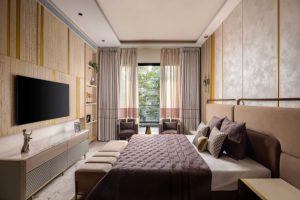SCREENS IN DISGUISE
Team L&M
How designers are making technology vanish into walls
Rashi Bothra and Ruchi Gehani, Founders and Interior Designers, Azure Interiors
In many modern homes, technology is everywhere, but designers are finding smart ways to make it less visible. Instead of mounting screens and devices out in the open, they are being hidden behind panels, mirrors, or artworks. For example, a TV might be placed behind a sliding wooden panel or a mirror that turns into a screen when switched on. This helps keep the space looking clean and stylish, without all the tech taking centre stage. The idea is to blend technology into the design so it feels like a natural part of the room.
Materials like tinted glass, fluted wood, and clever cabinetry are often used to hide screens when they are not in use. Designers are also using smart home features like voice commands and sensors to reduce the need for visible buttons or remotes. It’s not about getting rid of tech, but about using it in a thoughtful way. The result is a home that feels warm and welcoming, with all the benefits of technology quietly working in the background.
Aashi Gupta, Founder and Principal Architect – Aashi Gupta Designs
In contemporary interiors, technology is being subtly integrated to preserve a home’s aesthetic appeal. Rather than placing devices prominently, designers are concealing them behind fluted wood panels, tinted glass, or artworks that double as screens. Televisions, for instance, may be hidden behind sliding cabinetry or mirrored surfaces that transform when in use. Smart features like voice control and motion sensors further reduce visual clutter by replacing traditional remotes and switches. This approach doesn’t eliminate technology; instead, it weaves it seamlessly into the design, creating spaces that are sleek, serene, and effortlessly functional without compromising warmth or visual harmony.
Ritu Gupta, Founder and Interior Architect – Nadora by Ritu Gupta
Today’s homes are embracing a more discreet approach to technology, where function meets finesse. Rather than showcasing devices, designers are opting to tuck them away behind custom cabinetry, within reflective surfaces, or disguised as decorative elements. A mirror might double as a screen, or a sleek panel might slide to reveal a television. This approach shifts the focus back to the design, allowing interiors to feel curated and cohesive. With the help of automation voice assistants, motion sensors, and app-based controls homes maintain their tech-savvy edge without visual noise. The result is a more fluid, elegant environment where technology supports, not dominates.




